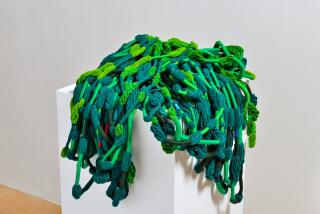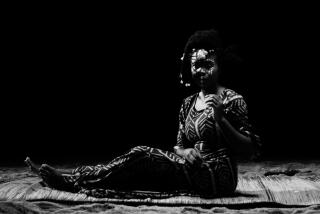Weavers Bring Renown to Poor Botswana : Africa: The 41 village women are turning out an astonishing array of woolen textiles that mirror their land.
- Share via
OODI, Botswana — Amid the golden hills of eastern Botswana, not far from the border with South Africa, a craft and art form usually associated with Scandinavia and Central America has taken root with an African flair.
In this village of about 500 inhabitants, a collective of women weavers laboring over hot vats of dye, looms and elaborate weaving frames turns out an astonishing array of woolen textiles that have acquired international renown.
The workers, known here as the Weavers of Oodi, are 41 women who have turned the hardships of familial separation--many have husbands laboring in South Africa--to their advantage.
“I have a man, but he is in South Africa. He digs in the gold mine,” said Charlotte Lokola, 40, who has eight children and is a part-time weaver and informal visitor’s guide at the Lentswe La Oodi Producers Cooperative. “He sends money from time to time, but it is still so difficult. My work makes life a bit easier. It’s certainly better than waiting around and doing nothing at all.”
Nearly 18,000 men from Botswana border towns work full-time in South African gold mines, a significant labor migration that reflects this nation’s continued economic dependence on its southern neighbor 25 years after Botswana gained political independence.
More than 80% of Botswana’s imports, for example--including all of its food, fuel and machinery--still come from South Africa.
But as the Weavers of Oodi seem to attest, economic dependence is sometimes just a state of mind. Their men may be gone for months at a time, but they still get along quite nicely, thank you.
The other day, a dozen women were working wonders on the wooden weaving frames, their fingers nimbly manipulating numerous lines of colored woolen thread. Several were creating tapestries, tablecloths and bedspreads in the warm, soft colors of the Botswana countryside--yellow, brown, pink and rust.
Working without sketches or patterns to guide them, the women turn out surprisingly intricate textiles, most with scenes evoking the simple joys of life in the African countryside: children gleefully leaving school at day’s end, elephants and flamingos frolicking by a lake, peasant families working together to harvest gardens brimming with produce, and herders standing watch over fat, sturdy cattle. The scenes are filled with the brilliant greens of grasslands and bright blues of sun-drenched skies.
In a land where traditional arts and crafts have usually taken the form of basketry, ceramic pottery or the ancient cave-side paintings of Kalahari desert bushmen, weaving is a relatively new art. It began in 1973 with the help of a Swedish couple, Ulla and Peter Gowenius, who, based in Botswana for several years, trained a few rural women to weave in their spare time and invested in the cooperative’s first looms and other start-up costs.
Those first weavers trained others, and the women soon began to acquire a reputation not only for excellence in their creations of serapes, shawls, wall hangings and rugs but also for proudly infusing the foreign art form with African themes. Over the years, the older generation of weavers has trained a new one and seen the cooperative grow in such favor that its works have been exhibited in several art galleries in Europe.
Large tapestries woven by the Weavers of Oodi hang today in leading hotels and government buildings in Gaborone, the capital, 45 miles to the southwest. The women, in fact, are considered something of a national treasure in Botswana, and their village is frequently visited by foreign dignitaries.
Unfortunately, with the Persian Gulf crisis and the resulting sharp drop in tourism in Botswana and the rest of Africa, the Weavers of Oodi last year made less than half of the $90,000 the cooperative usually earns in a good year.
Several weavers also complained that their government prevents the cooperative from marketing its own wares, preferring to market the goods itself through the government-run Botswana Development Corp. “We should be getting more for our work, I think,” one said. “There is such a big markup on the price between here and Gaborone.”
The Weavers of Oodi have come to love their own work as much as any creative artists. “I would like to have these items in my own home,” said Tebogo Tlhagwane, her fingers running along the smooth surface of a colorful tapestry she was weaving. “But the cost is much too dear.”
More to Read
Sign up for Essential California
The most important California stories and recommendations in your inbox every morning.
You may occasionally receive promotional content from the Los Angeles Times.










